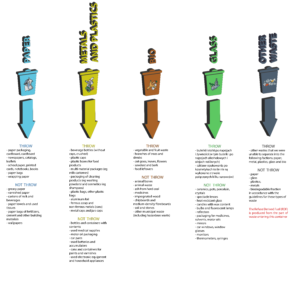The waste segregation system in Poland has been in force since 2013 (the waste revolution), according to which waste such as: metal, paper, glass, plastics, multi-material packaging (eg juice cartons) and biodegradable waste will be segregated. In practice, however, minor modifications to this division were possible, which in turn meant that each municipality segregated waste in a different way. The simplest and least effective way was to segregate into 3 waste fractions (dry waste – a red container / bag, glass – a green container / bag, mixed municipal waste – a black container / bag).
New segregation rules in Poland
In accordance with European Union (EU) directives, Poland must achieve the level of recycling and preparation for re-use of municipal waste fraction at the level of 50% by 2020. The fractions considered for recycling are paper, metal, plastics and glass. The level of recycling of these 4 factions achieved in our country in 2015 was only 26% – it is a very low level. Failure to reach the required levels of recycling in 2020 will result in Poland imposing high fines of up to 300,000 euros. Hence the need to introduce new rules for the collection of selective waste. In addition, the lack of uniform rules for separate collection of waste would risk losing EU funds for waste management infrastructure in the amount of about PLN 1.3 billion. These funds could be allocated to investments that facilitate citizens’ waste management.
In reference to the above-mentioned levels of recycling, on 1 July 2017 a new law came into force – the Regulation of the Minister of the Environment of December 29, 2016 on the detailed method of selective collection of selected waste fractions.
This law introduces new rules for municipal waste segregation that will apply throughout the country. The selective collection is divided into four factions. Paper – blue container / bag, glass – green container /bag (with the possibility of separating into clear glass – white container / bag and colored glass – green container / bag), metals and plastics yellow container / bag, biodegradable waste – brown container / bag. Therefore, waste should be placed in mixed waste containers, only when they do not suit to above-mentioned groups.

The commune will have five years to replace waste containers, for new ones in 5 colors (up to 30 June 2022). The Ministry of the Environment also introduced a transitional period due to the necessity to terminate existing agreements with companies collecting waste. This means that the introduction of new waste segregation rules in individual municipalities will take place on dates dependent on the time of completion of these contracts, but no longer than until 30 June 2021.
Waste is valuable raw materials that can be returned as new items under appropriate processes. We encourage you to properly segregate waste. Metal Expert as a conscious player on the waste management market, designs EL PIRO installations based on the hierarchy of proper waste management. Our installations are designed for waste that could not be recycled.
Download leaflet – New waste segragation rules in Poland
Sources:
https://www.mos.gov.pl/aktualnosci/szczegoly/news/abc-segregacji-odpadow/
https://www.mos.gov.pl/aktualnosci/szczegoly/news/wiecej-recyklingu-mniej-skladowania/
The Regulation of the Minister of the Environment of December 29, 2016 on the detailed method of selective collection of selected waste fractions.
